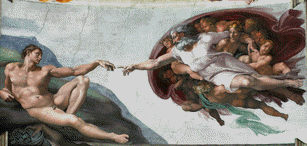Life is a gift, and it comes packaged as
a body beautiful. From
conception it unfolds and grows in mysterious wonder
until it births
forth to exclaim with joy, "I am here!"
Thus the sweet mystery of life
is revealed for eyes to see, ears to hear, and hands
to touch the
marvel of YHVH's handiwork up close and personal.
Life is sacred,
and its revelation is a daily discovery for those who
cherish and
reverance Him Who made the body beautiful. Profound
in wisdom,
the human form is uncompromised in design, proving
the inerrant
ability of the Most High to bring into being replicas
of Who He is
on a level that we can experience. This is a reality
that both
mystifies and inspires.
So it is that the body beautiful should
draw us with rapt desire to
discover its excellent intricacies and ultimately
challenge us to take
better care: to honor and cherish the body beautiful
that the Most
High has given in love.
While the finite mind cannot comprehend
the magnitude of the
Infinite, it can appreciate in measure the grand
precision found
in the body beautiful. Thus be awed if not humbled by
the following
presentation and regard it as inspiration toward a
deeper
understanding and more fervent commitment to care for
the body
beautiful that we might be strong and healthy
together as the
Ever-Living so desires.

I
will praise thee; for I am fearfully and
wonderfully made:
marvellous are thy works; and that my
soul knoweth right well.
Psalms 139:14
The body contains
10,000,000,000,000,000,000,000,000,000 atoms
which is more than the number of stars in the
universe.
90 per cent of our atoms are
replaced annually and 100 percent of our
atoms turn over and become new atoms.
In the last hour, one trillion
trillion of our atoms have been replaced.
The body contains between 10 and 100
trillion cells and each cell
contains approximately a trillion atoms.
Cells are constantly being torn
down, remodeled, and replaced.
Every few days the cells in the intestines are
replaced.
The life span of cells varies from
less than a day to years. Red blood
cells live four months. Certain muscles cells
live for years. Nerve cells
can live one hundred years.
Each cell is surrounded by a
membrane that is thinner than a spider's
web that must function properly or the cell will
die.
Each cell generates its own
electrical field, which at times is larger
than the electric field near a high-voltage power
line.
Each cell has its own internal clock
that switches on and off in cycles
from two to twenty-six hours without variance.
The body has sixty thousand miles of
blood vessels which is a
distance of nearly 2.5 times around the earth at
the equator.
Capillaries are so small that their
average diameter is the same size
as a red blood cell. This means that the red
blood cell must often flow
hrough a capillary single file and sometimes even
distort itself to
make it through.
One breath contains 150 million
molecules, and we breathe about
23,000 times per day and 630 million times during
the average
life span.
The average speed of a sneeze is 68
miles per hour.
The human eye can distinguish
millions of shades of color.
On a clear, dark night we can see a
small candle flame from
30 miles away.
Tears are salty because they are
derived from the salt water
in the circulatory system and they are sterile
because they contain bacteria-destroying enzymes.
On average we automatically blink
about every two to ten seconds
and over 400 million times in a lifetime.
The cornea has extraordinary
sensitivity to touch, and anesthesiologists
test this corneal reflex to assess depth of
anesthesia prior to general
surgery.
The ear has a million moving parts
and is a microphone, an acoustical
amplifier, and a frequency analyzer.
The sense of smell is estimated to
be about ten thousand times more
sensitive than the sense of taste.
The nose can distinguish ten
thousand different smells.
The sense of touch incorporates many
distinct elements such as
pressure, pain, heart, cold and touch. The body
has 450 touch cells
per square inch of skin.
The brain weighs three pounds and is
the most complex and orderly
arrangement of matter known in the universe.
The average stomach has about a one
quart capacity.
The digestive tract is a 93 percent
efficient energy extractor.
The small intestine is twenty two
feet long.
The adult human has 206 bones, a
number that is decreased
40 percent from infancy due to fusion of adjacent
bones.
Bones are composed of mineral
crystals (mostly calcium and
phosphorus), collagen, and cells. This composite
is as strong as
granite in compression and 25 times stronger than
granite under
tension.
The femur is stronger than
reinforced concrete and must bear an
average of 1,200 pounds of pressure per square
inch with each step.
The mid-shaft of the femur is
capable of supporting a force of six tons
before it fractures.
Of the two to four pounds of calcium
in the body, nearly 99 percent
is in the bones and teeth.